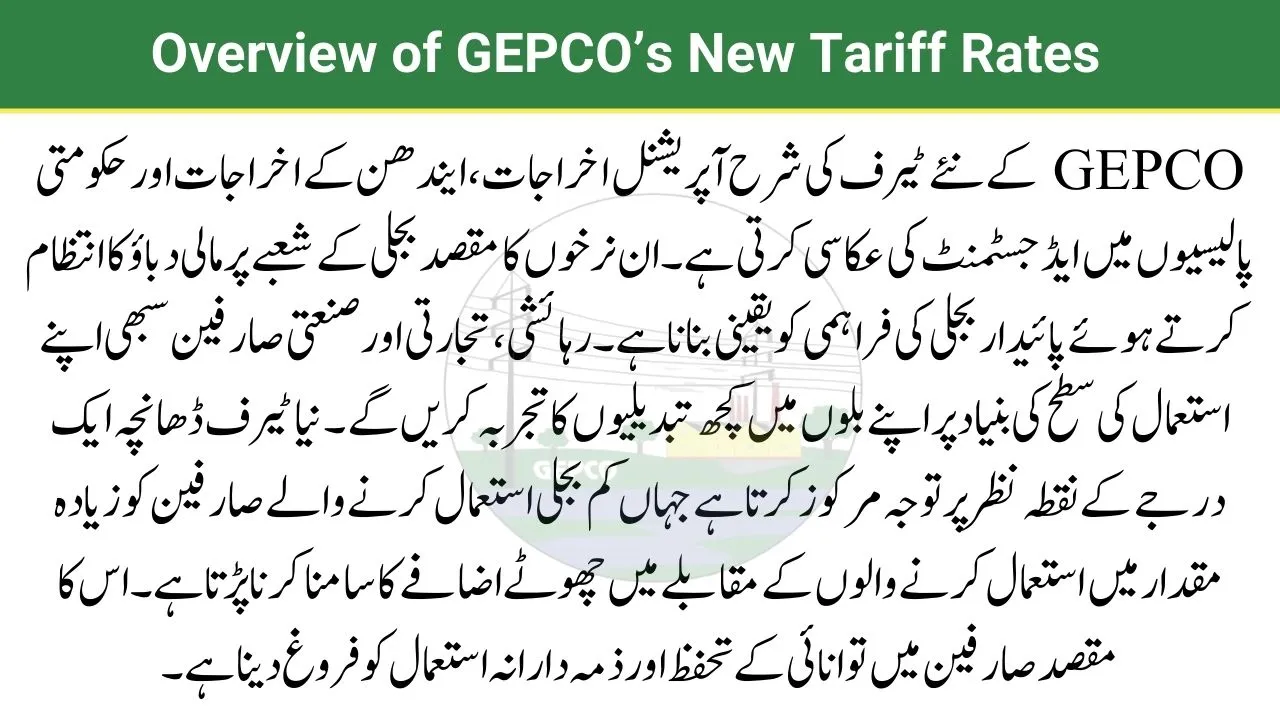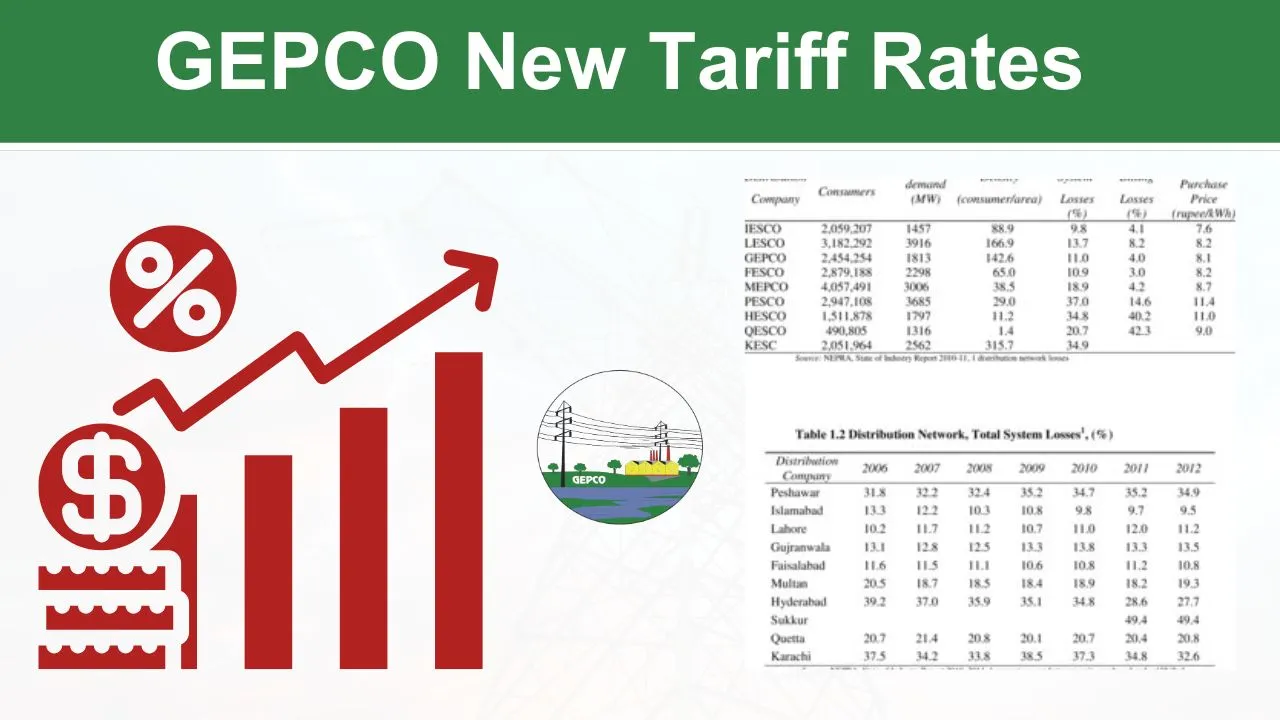Electricity bills are a crucial part of every household and business budget, and understanding the new rates helps in better financial planning. GEPCO (Gujranwala Electric Power Company) has announced updated tariff rates for 2025, approved by NEPRA. These changes are designed to adjust for rising operational costs and fluctuations in fuel prices. In this article, we will discuss these new rates, their impact on different consumer categories, and tips for managing electricity usage effectively.
| Component | Description |
| Basic Tariff | Standard rate per electricity unit |
| FPA | Fuel Price Adjustment based on costs |
| QTA | Quarterly Tariff Adjustments |
| Taxes | Government levies like GST |
Contents
Overview of GEPCO’s New Tariff Rates
GEPCO’s new tariff rates reflect adjustments in operational expenses, fuel costs, and government policies. These rates aim to ensure a sustainable power supply while managing financial pressures on the electricity sector. Residential, commercial, and industrial consumers will all experience some changes in their bills based on their consumption levels. The new tariff structure focuses on a tiered approach where users with lower electricity consumption face smaller increases compared to those consuming higher amounts. This is intended to promote energy conservation and responsible usage among consumers.

You may also read: How to Pay GEPCO Bill in Installments and Extend Due Dates 2025
Residential Tariff Adjustments
- The first 50 units remain subsidized, making them affordable for low-income households.
- Rates progressively increase as electricity consumption rises.
- Consumers using between 51 and 200 units will face a moderate increase in rates.
- Households consuming above 300 units will experience a significant hike in rates.
- The tiered system promotes energy efficiency by encouraging controlled electricity usage.
- Households with lower consumption will have smaller impacts on their bills compared to those with higher usage.
Commercial Tariff Adjustments
Commercial consumers, such as shop owners and small businesses, will also notice changes in their electricity costs. Small businesses using low amounts of electricity will see only a slight increase in their bills, whereas larger commercial entities, like factories and shopping malls, will face higher rates. This differentiation ensures fairness, as high-demand users bear more of the cost. The government encourages businesses to adopt energy-saving practices, such as switching to energy-efficient appliances and reducing unnecessary electricity usage during peak hours, to manage costs effectively under the new tariff system.
Industrial Tariff Adjustments
Industrial consumers are an important segment for GEPCO, as they contribute significantly to electricity demand. The new rates for industries focus on balancing operational costs with economic growth. While there is a noticeable increase in tariffs for heavy industries, the adjustments aim to minimize disruptions to industrial operations. Medium-sized industries with moderate electricity needs will face comparatively smaller increases. Industries are encouraged to adopt efficient energy management practices, such as investing in renewable energy solutions like solar power, to reduce dependency on grid electricity and lower overall costs.
Fuel Price Adjustment (FPA) and Quarterly Tariff Adjustments (QTA)
The Fuel Price Adjustment (FPA) and Quarterly Tariff Adjustments (QTA) are key components of the new tariff structure. FPA reflects fluctuations in fuel costs, which directly impact electricity generation expenses. This component may vary month-to-month based on international fuel prices. Similarly, QTA adjusts the tariffs every three months to account for changes in generation and distribution costs. Both these components ensure that the electricity sector remains financially stable while maintaining transparency in cost adjustments. Consumers should regularly check their bills to understand these adjustments and plan their budgets accordingly.
Tips for Managing Electricity Costs
To manage your electricity bills under GEPCO’s new tariff rates, consider adopting energy-saving practices. Switch to energy-efficient appliances, such as LED lights and inverter-based air conditioners, which consume less power. Limit the use of heavy appliances like air conditioners and water heaters during peak hours to avoid higher charges. Make it a habit to turn off lights, fans, and other devices when not in use. Additionally, consider installing solar panels to reduce dependency on the grid and take advantage of net metering options provided by GEPCO for further savings.

Conclusion
The new GEPCO tariff rates for 2025 reflect the evolving costs of electricity generation and distribution. These rates aim to promote energy conservation while ensuring the financial stability of the electricity sector. Understanding the new rates and how they impact your electricity bill is crucial for managing expenses effectively. By adopting energy-efficient practices and staying informed about tariff adjustments, consumers can reduce their electricity costs and contribute to a more sustainable energy future.
Also Read: GEPCO Electricity Disconnection Rules 2025
FAQs
What are the key changes in GEPCO’s tariff rates for 2025?
The key changes include increased rates for higher consumption slabs, revised FPA, and QTA adjustments to account for rising operational costs.
How can residential consumers reduce their electricity bills under the new rates?
Residential consumers can reduce their bills by conserving electricity, using energy-efficient appliances, and limiting usage during peak hours.
What is the Fuel Price Adjustment (FPA) in electricity bills?
FPA reflects changes in international fuel prices and adjusts electricity rates accordingly.
Are businesses affected by GEPCO’s new tariff rates?
Yes, commercial and industrial businesses will experience increased rates, with larger entities facing higher adjustments compared to smaller ones.

